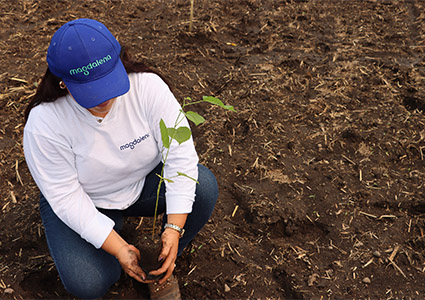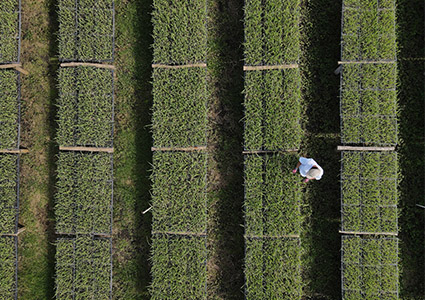Discover how Magdalena works to advance Guatemala’s renewable energy landscape
Guatemala’s advancement in renewable energy is spearheaded by Magdalena, a sugar processing company focused on driving a circular economy model. Through responsible agriculture and industrial projects, the organization maximizes production while ensuring soil protection. With a daily milling capacity of 40,000 metric tons, Magdalena is the only sugar cane mill in Guatemala capable of producing, marketing, and transmitting electric power, thus providing valuable support to the country’s energy landscape. CEO Jorge Leal sheds light on the company’s processes and its position within the Guatemalan energy market. “Family-owned since its establishment in 1983, Magdalena is a sugar business which produces and processes sugar cane to turn it into sugar, energy and alcohol. Not only is it the largest mill in America outside of Brazil, but also the biggest sugar refinery annexed to a sugar mill in the world,” he opens.
 “In terms of energy, we have been developing cogeneration projects to convert biomass into energy to supply the national grid. Guatemala boasts a fantastic and open energy sector where energy is created and supplied on an hourly basis with a system that prioritizes the lowest declared cost for energy production. The first producer to enter the market sets the price, and subsequent producers are added based on their cost, with all parties receiving payment based on the final cost set by the last producer to enter the market. At Magdalena, we generate between ten and 12 percent of the nation’s energy needs by combining several technologies to convert biomass into energy. Guatemala has two main seasons: a rainy season and a dry season, with mild, spring-like weather throughout the rest of the year. During the harvesting season, which runs from November through May, we generate electricity using bagasse and coal mainly imported from Colombia, and occasionally from the US. The energy sector is regulated by an autonomous entity called the Administrador del Mercado Mayorista, which determines which producers are brought in based on cost. If coal is included in the matrix of energy sources, it is prioritized and the producers who utilize coal are brought in to generate energy. As a result, the percentage of energy that we generate can vary, as we are called upon to generate energy based on the needs of the national grid,” Jorge adds.
“In terms of energy, we have been developing cogeneration projects to convert biomass into energy to supply the national grid. Guatemala boasts a fantastic and open energy sector where energy is created and supplied on an hourly basis with a system that prioritizes the lowest declared cost for energy production. The first producer to enter the market sets the price, and subsequent producers are added based on their cost, with all parties receiving payment based on the final cost set by the last producer to enter the market. At Magdalena, we generate between ten and 12 percent of the nation’s energy needs by combining several technologies to convert biomass into energy. Guatemala has two main seasons: a rainy season and a dry season, with mild, spring-like weather throughout the rest of the year. During the harvesting season, which runs from November through May, we generate electricity using bagasse and coal mainly imported from Colombia, and occasionally from the US. The energy sector is regulated by an autonomous entity called the Administrador del Mercado Mayorista, which determines which producers are brought in based on cost. If coal is included in the matrix of energy sources, it is prioritized and the producers who utilize coal are brought in to generate energy. As a result, the percentage of energy that we generate can vary, as we are called upon to generate energy based on the needs of the national grid,” Jorge adds.
Exploring technologies
In addition to its core energy generation activities, Magdalena runs two hydrogenation plants, among other endeavors. “These plants are operated in accordance with seasonality: they generate more during the rainy seasons when we are not harvesting, but less so during harvesting seasons in the dry months. Recently, we have entered the solar energy market where we are currently involved in two projects. The first is a 66-megawatt scheme set to come online in March 2025 and the other is a 32-megawatt project expected to be completed by June or July of the same year. We are also exploring other technologies, as there will be an important tender requiring distribution companies to commit their power and energy four years in advance, thereby promoting the development of new projects. Furthermore, we are considering a couple of projects in gas and more specifically, liquefied natural gas (LNG). As there are already two projects in Central America running on LNG – one in Panama and the other in El Salvador – we are evaluating the feasibility of building a similar project in Guatemala if the conditions are right and we are successful in the tender,” Jorge reveals.
Stable generation 
Going back to Magdalena’s two solar energy projects, Jorge unveils how they complement its core biogas operations. “There are two markets in Guatemala: distribution, where we participate through tenders, and big users, where we can only engage in private contracts if our power consumption exceeds 100 kilowatts. As big users, we have undertaken many private contracts for four major clients, catering to them by building our own project but also by acting as energy buyers, integrating technologies like hydropower and sourcing green energy to supply their large iron smelter. These clients include textile producers, bottlers, factories, plastic manufacturers, and vegetable exporters. By implementing solar power as a fixed energy source, we can provide long-term stability by fixing a portion of the energy prices for our clients.”
As the conversation goes on, Jorge explains the place of sugar cane energy in Guatemala’s overall energy generation landscape. “The sugar industry plays a crucial role in Guatemala and operates collaboratively as a group. Rather than competitors, we view each other as colleagues, sharing our technologies and findings to foster progress in the industry. Nearly every mill in our sector has invested in energy generation, making sugar cane a highly important source of energy during the dry harvesting season. Guatemala has abundant hydroelectric generation, and the sugar industry serves as an excellent complement to this hydropower when the seasons change. In other words, when hydroelectric power generation decreases, sugar cane energy production increases, striking the right balance during these times,” he says.
With around 85 percent of its energy being renewable, Magdalena is dedicated to minimizing its impact on the environment. Still, the company acknowledges the irreplaceable benefits offered by traditional energy generation sources like coal. “Since we need to be available for the grid all year long, we use coal to complement bagasse in energy generation, as our bagasse boilers can burn coal, and it would be difficult to find an alternative material that can be used in the boilers. While we still rely on coal, we also focus on better agriculture practices, such as carbon sequestering, reclaiming mangroves, and planting trees in other regions, in line with our commitment to being carbon negative by 2030. For the last four years, we have been increasing the levels of fungi and bacteria in our soils and taking measurements to collect useful data. Typically, when the World Bank calculates our carbon balance, it measures the cane from the soil up. However, we are proving that a significant amount of carbon is also being sequestered in the soil itself, as sugars produced by sugarcane are transferred as exudates to the roots, feeding fungi and bacteria.
“We believe coal can be utilized more responsibly and offers stability in places where the weather fluctuates significantly between rainy and dry seasons. While Guatemala enjoys relatively stable weather, we do encounter heavy rainfall variations. Thus, having various energy sources and processing technologies is crucial for guaranteeing the stability of Guatemala’s energy generation. Similarly, we view gas as a viable option that is more environmentally friendly than coal, albeit it does not complement bagasse as well. When comparing the carbon balance between bagasse and coal versus gas, bagasse and coal are likely to emit less carbon. Nonetheless, gas technology is promising, and we are exploring opportunities to incorporate it into our energy matrix,” Jorge ends.
Magdalena is a shining example of a circular economy in action, leveraging renewable energy to power the nation’s grid and drive sustainable development.

